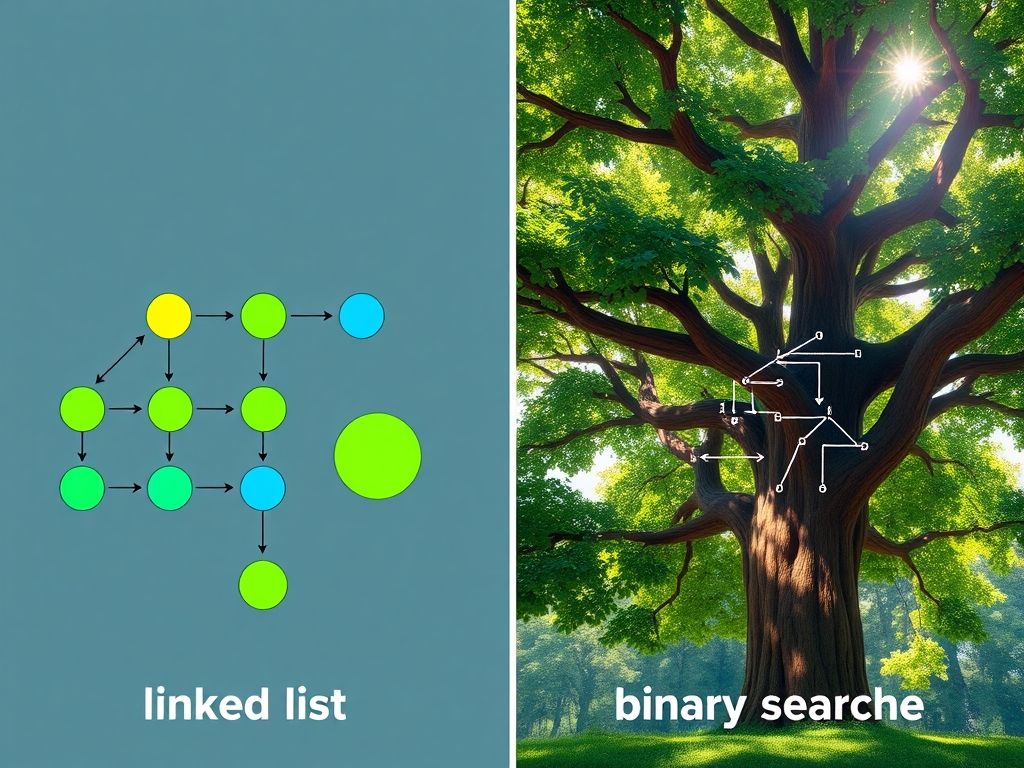Data structures are the fundamental building blocks of efficient algorithms. Understanding these structures is crucial for anyone working with data, from software developers to data scientists. This article explores the key concepts of data structures, focusing on linked lists, binary trees, and data structures algorithms, providing practical insights and examples.
Linked Lists: The Foundation of Data Structures
Linked lists are a fundamental data structure in computer science, serving as a building block for more complex structures. Understanding linked lists is crucial when delving into thuật toán cấu trúc dữ liệu (data structure algorithms). Unlike arrays, which store elements in contiguous memory locations, linked lists use a different approach.
Structure of a Linked List
A linked list is a linear data structure where elements are stored in nodes. Each node contains two parts:
- Data: The actual value being stored.
- Next: A pointer (or reference) to the next node in the sequence.
The first node in the list is called the “head,” and the last node’s “next” pointer points to null, indicating the end of the list. This chain of nodes linked together gives the linked list its name. There are several types of linked lists:
- Singly Linked List: Each node points only to the next node.
- Doubly Linked List: Each node points to both the next and previous nodes, allowing for traversal in both directions.
- Circular Linked List: The last node’s “next” pointer points back to the head node, forming a loop.
Advantages of Linked Lists
Linked lists offer several advantages over arrays:
- Dynamic Size: Linked lists can grow or shrink dynamically at runtime. You don’t need to predefine the size as you do with arrays. This makes them ideal for situations where the number of elements is unknown or changes frequently.
- Efficient Insertion and Deletion: Inserting or deleting elements in the middle of a linked list is generally faster than in an array. In an array, inserting or deleting an element requires shifting subsequent elements to maintain contiguity. In a linked list, you only need to update the “next” pointers of the surrounding nodes.
- Memory Efficiency: Linked lists can use memory more efficiently than arrays, especially when dealing with large objects. They allocate memory only when needed, whereas arrays may allocate a large block of memory upfront, even if it’s not fully utilized.
Disadvantages of Linked Lists
Despite their advantages, linked lists also have drawbacks:
- Random Access Not Allowed: Unlike arrays, you cannot directly access an element in a linked list by its index. You must traverse the list from the head until you reach the desired node. This makes accessing elements slower than in arrays, which offer constant-time access.
- Extra Memory Space: Each node in a linked list requires extra memory to store the “next” pointer (and “previous” pointer in a doubly linked list). This overhead can be significant, especially for small data elements.
- Cache Inefficiency: Linked lists can be cache-inefficient because the nodes are not stored in contiguous memory locations. This can lead to more cache misses and slower performance.
Real-World Applications
Danh sách liên kết (linked lists) are used in various real-world applications:
- Implementing Stacks and Queues: Linked lists can be used to implement stacks and queues, which are fundamental data structures used in many algorithms and applications.
- Dynamic Memory Allocation: Operating systems use linked lists to manage free memory blocks.
- Symbol Tables: Compilers and interpreters use linked lists to store symbol tables, which map variable names to their corresponding values.
- Music Playlists: Music players often use linked lists to manage playlists, allowing users to easily add, remove, and reorder songs.
- Hash Tables: Linked lists are used in hash tables to handle collisions. When multiple keys hash to the same index, a linked list is used to store the colliding elements.
Comparison with Other Data Structures
Compared to arrays, linked lists offer more flexibility in terms of size and insertion/deletion, but they lack random access. When considering cây nhị phân (binary trees), linked lists provide a simpler linear structure, while binary trees offer hierarchical organization and efficient searching, at the cost of increased complexity in implementation and memory usage. The choice between these data structures depends on the specific requirements of the application.
Linked lists serve as a crucial foundation for understanding more advanced data structures and algorithms. The next step in our deep dive will be to explore binary trees, another essential data structure.
Following our exploration of “Linked Lists: The Foundation of Data Structures”, where we discussed the structure, advantages, and disadvantages of linked lists and compared them to other data structures, we now turn our attention to another fundamental data structure: **Binary Trees**. Linked lists provide a linear way to organize data, but binary trees offer a hierarchical structure, enabling more efficient searching and sorting in many scenarios. The concepts of *thuật toán cấu trúc dữ liệu* (data structure algorithms) become particularly relevant when working with binary trees, as specific algorithms are designed to leverage their unique properties.
Binary Trees: A Powerful Data Structure
A binary tree is a hierarchical data structure in which each node has at most two children, referred to as the left child and the right child. The topmost node in the tree is called the root. This structure allows for efficient searching, insertion, and deletion operations, making it a versatile tool in computer science.
Structure of Binary Trees
A binary tree consists of nodes, each containing a data element and pointers to its left and right children. If a node has no children, it is called a leaf node. The height of a binary tree is the length of the longest path from the root to a leaf node.
Binary Search Trees (BSTs)
A special type of binary tree is the binary search tree (BST). In a BST, for each node, all nodes in its left subtree have values less than the node’s value, and all nodes in its right subtree have values greater than the node’s value. This property allows for efficient searching. The efficiency of searching in a BST depends on its balance. A balanced BST provides logarithmic time complexity for search operations, while a skewed BST can degrade to linear time complexity.
Advantages of Binary Trees
- Efficient Searching: BSTs provide efficient searching capabilities, especially when the tree is balanced. The average time complexity for searching, insertion, and deletion is O(log n), where n is the number of nodes.
- Hierarchical Data Representation: Binary trees are well-suited for representing hierarchical relationships, such as organizational structures or file systems.
- Sorting: Binary trees can be used for sorting data efficiently. In-order traversal of a BST yields a sorted sequence of elements.
Disadvantages of Binary Trees
- Space Overhead: Each node in a binary tree requires space for data and pointers to its children, which can result in higher memory consumption compared to other data structures like arrays.
- Complexity of Implementation: Implementing binary tree operations, such as insertion and deletion, can be more complex than with simpler data structures like linked lists. Maintaining balance in a BST also adds complexity.
- Performance Degradation: In the worst-case scenario (e.g., a skewed tree), the performance of a binary tree can degrade to O(n) for search, insertion, and deletion operations.
Real-World Applications
Binary trees are used in various real-world applications:
- Search Engines: Search engines use binary search trees or similar tree-based structures to index and search for web pages efficiently. The *cây nhị phân* (binary tree) structure allows for quick retrieval of relevant documents based on search queries.
- Compilers: Compilers use syntax trees, which are a type of tree structure, to represent the structure of a program. This allows the compiler to analyze and optimize the code efficiently.
- Databases: Databases use tree-based indexes to speed up data retrieval. B-trees, a generalization of binary search trees, are commonly used for indexing in databases.
- File Systems: File systems often use tree structures to organize directories and files. This allows for efficient navigation and retrieval of files.
The choice between using a linked list and a binary tree depends on the specific application requirements. Linked lists are suitable for dynamic data storage where frequent insertions and deletions are needed, while binary trees excel in scenarios requiring efficient searching and hierarchical data representation. Understanding the trade-offs between these data structures is crucial for effective software development. The study of *thuật toán cấu trúc dữ liệu* helps in making informed decisions about which data structure to use in a given situation.
In the next chapter, we will delve into specific algorithms used with linked lists and binary trees, such as searching, insertion, and deletion, and analyze their time and space complexity. This will provide a deeper understanding of how to optimize algorithms for specific use cases and further enhance our ability to leverage the power of these fundamental data structures.
Data Structure Algorithms: Optimizing Efficiency
Building upon our understanding of data structures, particularly from the previous discussion on “Binary Trees: A Powerful Data Structure,” where we explored the structure, advantages, and real-world applications of binary trees, including their role in implementing search engines, we now delve into the algorithms that unlock their full potential. This chapter focuses on optimizing efficiency through common algorithms used with linked lists and binary trees, analyzing their time and space complexity, and providing examples of optimization strategies.
Let’s begin with **linked lists**. A **danh sách liên kết** (linked list) is a linear data structure where elements are not stored in contiguous memory locations. Instead, each element (node) contains a value and a pointer to the next element in the sequence. Common algorithms performed on linked lists include searching, insertion, and deletion.
*Searching*: A simple linear search iterates through the list, comparing each node’s value to the target value. In the worst-case scenario, we might have to traverse the entire list, resulting in a time complexity of O(n), where n is the number of nodes. Space complexity is O(1) as we only need a constant amount of extra space.
*Insertion*: Inserting a node at the beginning of the list takes O(1) time, as we only need to update the head pointer. Inserting at a specific position requires traversing the list to find that position, resulting in O(n) time complexity in the worst case. Space complexity is O(1).
*Deletion*: Deleting the first node also takes O(1) time. Deleting a node at a specific position requires traversing the list to find the node and updating the pointers, resulting in O(n) time complexity. Space complexity is O(1).
Optimization for linked lists often involves using techniques like caching frequently accessed nodes or using doubly linked lists, which allow for faster traversal in both directions, improving deletion performance in some scenarios.
Now, let’s consider **binary trees**, specifically focusing on binary search trees (BSTs). A **cây nhị phân** (binary tree) is a hierarchical data structure where each node has at most two children: a left child and a right child. In a BST, the value of each node is greater than all values in its left subtree and less than all values in its right subtree.
*Searching*: Searching in a BST can be very efficient. We start at the root and compare the target value with the node’s value. If the target is smaller, we go to the left subtree; if it’s larger, we go to the right subtree. In the best case (target is the root), the time complexity is O(1). In the average case, the time complexity is O(log n) for a balanced tree. However, in the worst case (a skewed tree resembling a linked list), the time complexity degrades to O(n). Space complexity is O(1) for iterative implementations and O(log n) for recursive implementations due to the call stack.
*Insertion*: Inserting a node into a BST involves a similar process to searching. We traverse the tree until we find the appropriate position to insert the new node, maintaining the BST property. The time complexity is O(log n) on average and O(n) in the worst case. Space complexity is similar to searching.
*Deletion*: Deletion is the most complex operation in a BST. There are three main cases: deleting a leaf node (simple removal), deleting a node with one child (replace the node with its child), and deleting a node with two children (find the inorder successor or predecessor, replace the node with it, and then delete the successor/predecessor). The time complexity is O(log n) on average and O(n) in the worst case. Space complexity is similar to searching.
To optimize BST performance, especially to avoid the O(n) worst-case scenarios, we can use self-balancing binary search trees like AVL trees or red-black trees. These trees automatically adjust their structure during insertion and deletion to maintain a balanced state, ensuring that the height of the tree remains logarithmic, thus guaranteeing O(log n) time complexity for search, insertion, and deletion operations.
In the realm of **thuật toán cấu trúc dữ liệu** (data structure algorithms), understanding the trade-offs between different algorithms and data structures is crucial. The choice of algorithm and data structure depends heavily on the specific use case and the expected operations. For example, if frequent insertions and deletions are required, a linked list might be more suitable than a static array. If efficient searching is paramount, a balanced binary search tree is often the best choice. Furthermore, understanding the time and space complexity of different algorithms allows for informed decisions, leading to more efficient and scalable solutions.
The next chapter will delve into [Next Chapter Topic].
Conclusions
Mastering data structures unlocks the potential for efficient and scalable software. By understanding linked lists, binary trees, and the algorithms that operate on them, developers can create robust and performant applications. This knowledge is essential for tackling complex programming challenges.











